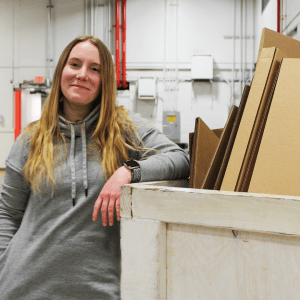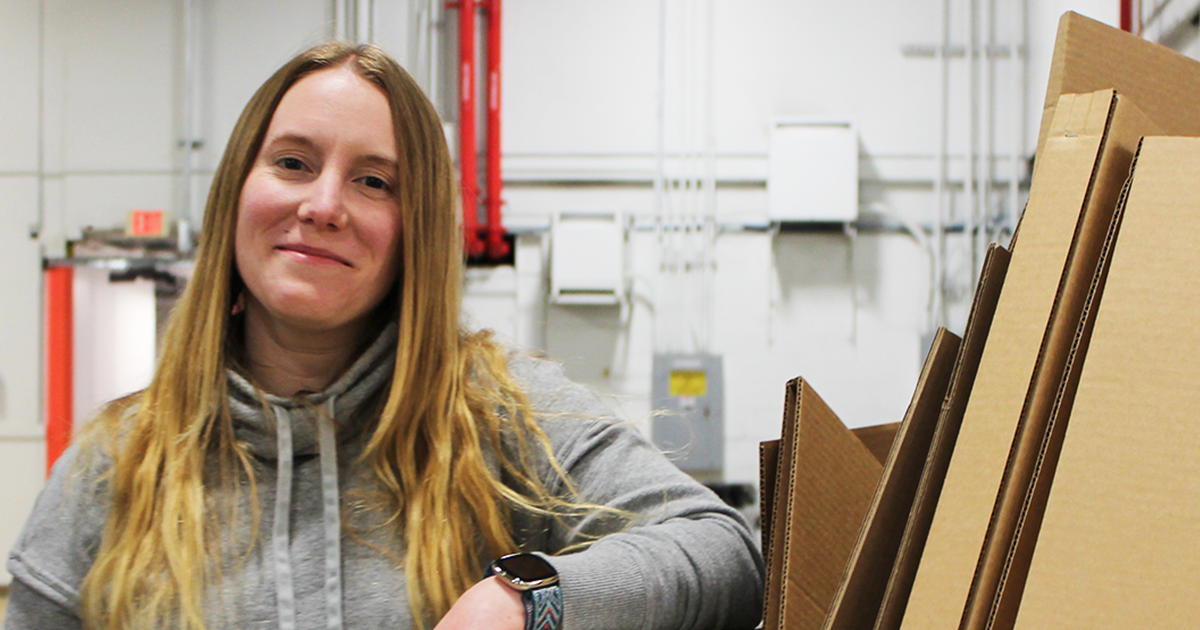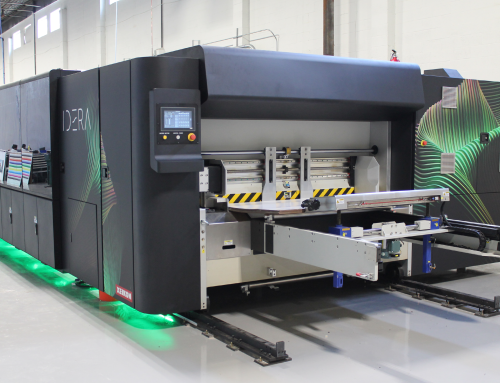As a company, we believe in the importance of sustainability in the workplace and our three faculties. Over the years, the efforts have been company-based and employee-motivated.
Being Sustainable
Hannah takes extra corrugated from recent samples to our in-house recyclable bin for compacting. Corrugated is the ideal material for eco-friendly packaging due to its high recyclability. Better yet, it’s readily biodegradable and has a much lighter carbon footprint in its manufacturing.

Hannah takes extra corrugated from recent samples to our in-house recyclable bin for compacting.
Corrugated materials are even beneficial for composting as well. According to the EPA’s 2018 survey, approximately 67% of recycled materials are comprised of paper and paperboard.
The packaging industry can aspire to become more environmentally conscious, from sourcing the material through sustainable forestry to substituting plastic packaging with paperboard.
Using corrugated inserts and partitions over plastic padding between fragile items is another great way to reduce the need for single-use plastics in packaging. At ProCorr Display & Packaging, we even produce corrugated partitions and offer this service to our customer base. Since the materials used in our facilities are eco-friendly, it helps make sustainability in the workplace more accessible.
Our Ink Lab utilizes water-based inks for our flexographic printing jobs. Many printing inks can contain plastics and other synthetics, which are harmful to water quality wildlife, unsafe for food, and even human health. Water-based solvent inks are better for us all without compromising print quality.
Also, all excess board scraps from our machinery are bailed in our production plant. Even board scraps from our de and our sample table are bailed, picked up, and recycled into brand new corrugated sheets, making corrugated favorable as a renewable material.
Meet Hannah, Our “Greenest” employee yet!
However, one employee who takes ownership of being more sustainable is our Designer, Hannah. At home, she recycles and tries to avoid single-use products. Rather than using paper towels, she uses cloth towels. In addition, she buys bulk food in recycled containers over plastic bagged fruits and grains. She composts food scraps and paper scraps (including pizza boxes).
Hannah shares, “I recycle the standard glass, paper, and applicable plastics in my home bin. I also take things a step further by dropping off items that cannot be picked up with my regular recycling but can be recycled, such as plastic shopping bags and granola bar wrappers at a local collection site.”
Depending on the municipality, what can and can’t be recycled can vary yearly as contracts with the recycling and pick-up company are renewed. However, intentionally purchasing items made up of or packaged in paper board material gives you the confidence that you are making an eco-friendly choice. With that in mind, Hannah will take home anything from corrugated scraps that are too small to be bailed to printed labels and office papers that her current local recycling contract allows.
In addition, she also washes and brings home plastic containers and items such as broken electronics and old batteries to recycling centers. Recycling takes less energy than needed to create new materials and helps push manufacturing toward sustainability with a more closed-loop system. The waste that we don’t recycle ends up in landfills, where it takes much longer to break down. These landfills become overcrowded, and the lining can often leak, allowing toxins to enter the groundwater beneath.

Hannah, our lead designer, leads the team with her green efforts!
Impacts of Recycling
Waste that does not end up in a landfill could also be incinerated, a harmful process to air quality with exponential side effects on climate. Improperly disposing of waste that becomes litter is also a problem for natural lands and waterways.
A shocking amount of litter ends up washing into streams and tributaries in larger bodies of water, traveling great distances from its original dumpsite where wildlife, mainly aquatic, can swallow or become tangled by items such as can holders or Q-tips. Most plastics take between 100 and 400 years to break down entirely.
Sustainability In The Workplace
Hannah’s recycling efforts continuously inspire other team members in our current company culture. As a company, we understand that recycling and using more sustainable paper board material is one of the best steps to creating an environmentally friendly society.
With the combination of materials and technology we utilize in our facilities, we will continue to improve our current efforts to increase our sustainability in the workplace and help educate those on our staff to do their part.





